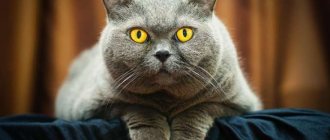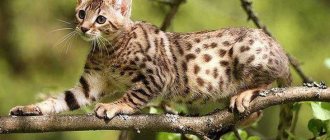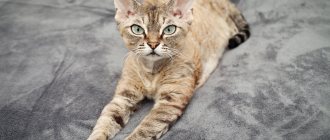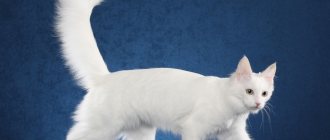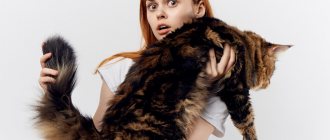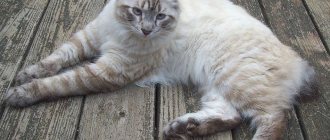Most breeds of domestic cats were formed on the basis of natural varieties of animals, some as a result of mutational changes in the gene set, a small number were deliberately created by humans by crossing special specimens.
At the same time, humanity is increasingly looking for the traits of a predatory animal in a pet, because the natural grace of these animals captivates and fascinates. Therefore, more and more varieties are created deliberately through hybridization - crossing wild and domestic cats. This is how the Caraquet breed was formed.
History of the Caraquet cat breed
Crossing wild and domestic cats is a complex process for which experienced felinologists prepare for a long time, selecting suitable animals. In the Caracat breed, the first experience was accidental and took place in the Moscow Zoo.
At the end of the last century, a large stray cat entered the enclosure of a male Caracal, and although the crossing of animals of such different sizes is not an easy process, copulation took place and the female became pregnant. Only one large male kitten was born, surprisingly similar to its father. He was significantly larger than his domestic peers, was distinguished by a ticked reddish color, had a shorter tail and tufts on his ears.
Read the article about Caraket’s wild ancestor – Caracal, where it lives, and whether it is possible to keep it at home.
The baby, strikingly similar to a lynx, surprised everyone. The caracal was indeed classified as this type of cat for a long time, but with the latest systematization it was separated into an independent genus. This animal has a strong, muscular, dense body, body length up to 80 cm, with a short tail, no more than 30 cm, an elongated round muzzle, large and high-set ears with large tassels. Expressive eyes often have bluish or blue irises. Read the article about the entire cat family to understand how many genera exist and who belongs to which. For example, did you know that a tiger and a lion are actually panthers? This and more is written about in this article.
Several press reports were published about the unique event; this incident excited all felinologists. After all, if such crossing occurred spontaneously, then breeding a new beautiful breed should not be difficult. The kitten was male and therefore sterile. The fact is that all hybrid males up to the fourth and sometimes even the fifth generation are not capable of producing offspring.
Conscious attempts at interspecific crossing have already been made by German and American breeders. For many years they did not bring the long-awaited results.
Finally, at the beginning of this century, Joy Gesinger from the United States of America was able to cross a male Caracal with an Abyssinian female. Full-fledged hybrid offspring of the first generation were obtained. The breeder even managed to register the new breed as an experimental sample in the American international association TICA, but the breeding work was interrupted after the death of the breeder.
Until 2014, the research of another American breeder, Alisson Navarro, who received first and second generation Caracat kittens, was published on the nursery’s personal pages and on Facebook. There is no information about the breeder’s further work or the reasons for her suspension.
At the same time, Russian breeder Irina Nazarova is dealing with a similar problem. From 2007 to the present day, she has been breeding male Caracals with Bengal and Abyssinian females. In 2022, the first generation was presented at major Moscow exhibitions and was even registered in the ICU system. This organization, although it is international, mostly represents felinologists from the territories of the former Soviet Union. The fact is that only animals from the fourth generation, if you count from a wild ancestor, can be considered a full-fledged breed of domestic cats.
Now the breeder has formed only three generations, so it is too early to talk about full recognition of the breed. When the description of Caraquet cats in subsequent generations after the fourth generation is made and approved by the largest international felinological organizations, such as the American TICA and the European WCF, then we can say with confidence that a new variety of domestic cats has taken place. Now these are only hybrid individuals, of which there are no more than eighty specimens in the world.
Interesting fact: the caracal, the ancestor of Caraqueta, is a close relative of the African serval, a description, photo and price of which you can find in a separate article on our portal.
Moreover, it is too early to assign laurels of championship, as is often done in Russian sources to one breeder. First of all, it is necessary to obtain stable generations of the fourth, fifth and sixth generations, without losing the breed characteristics, achieve male fertility, and then talk about who made what contribution to the formation of the Karakets.
Hybrids
Caraquet
Caracats are a “kind” copy of caracals, the fruit of love between a representative of the latter and an Abyssinian cat. For a long time, breeders suffered defeats in their attempts to breed hybrid offspring capable of reproducing. Our compatriot from Krasnodar was able to succeed in this at the end of the 20th century. Thanks to her, this mixture of cat and steppe lynx combines wild beauty and gentle disposition.
The conformation of this new breed of lynx-like cat is identical to the caracal: the same body size, coat color, long hind legs and ear tufts. However, their character is much calmer and more peaceful than that of their wild ancestors. They love to play and get along well with their pet neighbors.
Caracats are easy to train to walk in a harness. They also need a well-equipped playground that satisfies their wild instincts.
Domestic lynx
Thanks to the efforts of breeders, crossing the Canadian lynx with domesticated cats with spotted skins gives us the opportunity to have a real lynx, only a domestic one. She has the same long hind legs, shortened tail, graceful curve of the spine, expressive almond-shaped eyes and “signature” ear tufts.
Best articles: The most dangerous dog breeds
Individuals of the domestic lynx have thick gray-brown fur. Lynxes are incredibly beautiful, their fur has a gray-blue tint - it seems as if they have just rolled out in the snow.
Such a luxurious fur coat requires constant and thorough combing. Otherwise, the animal runs the risk of choking when licking
In general, caring for a domestic cat-lynx hybrid is identical to caring for a caracal or caraquet - a lot of movement, raw meat and constant attention
Caracal
The caracal is very similar in appearance to the lynx, but is slightly smaller in size. Just like the lynx, the caracal has dense, thick fur, lush dark tufts on the tips of the ears, and coarse bristly hair on the paws. It has a uniform red color with a whitish lower part. Melissas are rarely found - individuals with black coat color.
The caracal is a predatory animal, the original purpose of domestication was to help in hunting. Nowadays this exotic animal is purchased as a pet. Caracals are balanced and energetic. They are characterized by a love of games and affection, and curiosity.
The price varies from 400 to 500 thousand rubles.
You need to buy a pet at the age of 4-6 years and only in specialized nurseries.
If you buy at the market or on the Internet, there is a chance that you will purchase an animal that was caught in the wild and not accustomed to home conditions.
Such individuals are predatory and do not live at home.
Caracal
Grace and grace of the lynx
In nature, the lynx is a separate population of mammals, which in appearance is most similar to the cat population itself. Its dimensions do not exceed those of a large dog, which it slightly resembles with a short body and long legs. Lynxes are great at climbing rocks and trees. Its elongated hind legs, overgrown with hair in winter, help the animal to grip well on loose snow. A rather short tail does not prevent the lynx from moving through trees and mountains in the forest.
Lynxes live in the forests of central Russia, some European countries, the USA, Canada, Central Asia, as well as in the Scandinavian countries. The body length can reach up to 1.30 m, the height at the withers can be up to 0.7 m, and the weight varies from 5 to 30 kg. The coloring of these predators is quite varied: red, brown, smoky, etc. Characteristic features of the lynx: elongated hind legs, a small tail, and specific tufts on the ears.
Mr. Cat recommends: why a real Caraquet is so rare
From the above it is absolutely clear that real domestic Caraquets simply do not exist in the world. Therefore, we will talk here only about hybrids from crossing a Caracal and a domestic cat of the first, second and third generations.
The offspring of the F1 generation are called first generation hybrids. These kittens have half the blood of a wild animal, all males are sterile. If a female from this litter is mated, for example, with an Abyssinian cat, then cubs of the second generation will be born - F2, which will contain 25% of the blood of the wild ancestor. Similarly, animals of the third, fourth and subsequent generations appear.
Usually, with each generation there is a decrease in predatory wild signs, both external and behavioral. The animal's ability to socialize also increases.
The first generation of females is the most valuable for breeders, since these females can become worthy mothers of new generations. Males, on the other hand, have an extremely bright and beautiful appearance, practically indistinguishable from Caracal, although they are not capable of producing offspring.
Often F1 females are bred again to a Caracal male to produce another strong generation of expectant mothers.
The first felinologists working on the new breed initially used Bengal cats as females, but here there is a high probability of getting kittens with a tabby color, although the “wild” features are enhanced. After all, Bengals themselves are hybrid individuals, obtained as a result of long breeding work by the American breeder Jean Mill with an Asian leopard cat.
So far, those kittens of the first, second and third generations of Caraquets that exist are mostly in nurseries (females) and continue breeding work. Males live as pets in the USA, Russia and some European countries. Therefore, finding a Caracat kitten is extremely difficult and is a very expensive purchase.
Pros and cons of the breed
The caraquet, like any other cat breed, has both advantages and disadvantages:
| pros | Minuses |
| Interesting appearance | Rarity of the breed |
| High intelligence | Difficulty in breeding |
| Lack of aggression | High price of kittens |
Caraquets are hybrid cats with a non-standard appearance and interesting origin. They harmoniously combine the features of a wild animal and the affectionate nature of a pet.
Characteristics, breed standard Caracat
The Caracat today is one of the brightest, most beautiful, large and expensive hybrid cats. He is a worthy competitor to the legendary Savannah, you can also read about her on the Mister Cat website.
An adult male can reach a weight of 15-17 kg or even more, has a beautiful, athletic body, large dimensions, which are sometimes only slightly less than the size of the Caracal or even equal to them.
This is an animal with excellent physical shape, which has also adopted a calm and non-conflict character from the Caracal, so all felinologists in the world are very interested in the further development of this breed.
If we talk about the Caraquet breed standard, it still exists only in preliminary form, since even the fourth generation of animals has not been obtained. However, it is as follows:
- The first external assessment is an elegant appearance, original color, wild appearance.
- Dimensions - a large animal up to a meter in length, weight about 15 kg, height at the withers up to half a meter.
- The head is a wedge-shaped modification with rounded transitions; it does not have “chopped” contours or flat surfaces. The frontal part of the skull is wide and slightly more convex. The lower jaw is not excessively heavy, but well defined, and cannot be small or slanted. The maximum score for the head is 5, for the muzzle – 6 points.
- The nose is large, wide, with a “wild” convex shape. It can be pinkish or brick with a dark outline, or completely black.
- The eyes are large and expressive. The shape is almond-shaped. They cannot be too round or slanted. Has a dark and white outline. If there is a clearly defined wild “tear trail” running towards the nose from the inner corner of the eye, such an animal is valued higher. The maximum score is 6 points.
- The ears are set high and wide, large, and have practically no forward tilt. They end in black tassels, but the further the generation goes, the lower the likelihood of their presence. The auricle is evenly pubescent outside and inside, the back part is dark. They are rated on an eight-point scale.
- The body is of medium length, with well-defined, but not prominent muscles. The chest is quite wide, on the belly there is a well-formed fat fold, characteristic of Caracals. The neck is of medium length, strong. The maximum score is 15 points.
- The limbs are quite high, but proportional to the body, the muscles are well developed. The paw is wide, the toes are oval. They are scored accordingly by 5 points.
- The tail is wide and powerful at the base, tapering slightly to a rounded black tip. Has no markers or rings, and is generally longer than the Caracal but shorter than any other domestic cat. Scored up to 5 points.
- The coat is dense and shiny, soft to the touch, with undercoat. Texture and length are scored 5 points.
- The color is ticked, each hair can have two or three color rings, and they alternate with lighter areas. A stripe of a darker shade may run along the ridge line. The face welcomes the original “mask” of the Caracal – dark “tear tracks”, eye rims, markers on the areas of the brow ridges and ear pads. Markings may be on the stomach. Lighter hair in the abdominal and chest areas and on the inner surface of the paws is highly valued. The limbs may have ring stripes, but they must be open. Coat color tones range from reddish, Sorel-type, to cooler and grayish, as well as charcoal, chocolate and cinnamon. It is valued at 35 points, of which 10 are for ticking, the same for markings, 10 for color and 5 for the tones of the iris. It can be golden or greenish tones.
- Acceptable faults include closed ring markings on the limbs, tail, “medallions” and “necklaces” on the chest area, too cold and gray color colors, lack of black marks on the outside of the ears.
- An animal is disqualified for a bright white “medallion” on the chest and anywhere except the lower jaw and eyeliner, a defect in the tail, the presence of spots and stripes even in a residual form on the body, a gray tone of the lower layer of the coat, polydactyly, unacceptable and unrecognized colors.
- Permitted crossings until the final type has been established are allowed with Caracals, Abyssinian cats, Orientals, Serengetti, Bengals and any other breeds of domestic animals, if this is necessary to obtain wealthy offspring and improve breed qualities.
Caracal
All Caracats have excellent physical shape, quick reaction, and are able to jump in height and length up to three meters. The presence of fat reserves in the abdominal cavity makes these animals very hardy; they can go without food for a long time, even up to three days without water. As a legacy from the Caracals, these cats received excellent hearing, acute vision, a natural sense of smell and all the makings of twilight and daytime hunters.
The final color options for the Caraquet have also not yet been established. Animals can be light sandy shades, chocolate, reddish tones, even black and silver. Tabby in any areas except the belly and paws, as well as dirty gray tones, are unacceptable. Melanism (much darker coat, even black) is possible in Caracals and therefore their descendants can adopt this feature.
Currently, it is generally accepted to divide colors as follows:
- Wild - the main background is reddish-brown, the markings are black and white.
- Cinnamon - peach background and brown-red markings.
- Silver – it can be compared to the colors of snow leopards.
- Melanistic – black, chocolate.
Features of temperament
Before talking about the character of the new breed, it is necessary to briefly outline their wild ancestors.
Caracals have been tamed by people since ancient times; in the regions of their permanent residence, especially in Ancient Egypt, they were even used in hunting hares along with dogs.
This attitude of a person towards Caracal is explained by the calm and self-possessed character of the latter. The beast is rather cautious and cunning. It would be more correct to say that he has a high level of intelligence. Even when protected and frightened, the Caracal rarely shows its fangs to a person; it will rather brush it off with its paws, however, without releasing its claws. Although he is capable of killing a small animal, such as a goat, with one swing of his limb, or biting a hare in half.
If weaned early from the mother and raised in the arms, the Caracal can become a full-fledged pet. This sets it apart from other colorful wild small cats such as the Asian leopard cat or the ocelot. Therefore, hybrid offspring from Caracal simply cannot have a bad character. Even the first generations of Karakets are distinguished by an enviable temperament and high intelligence.
Pets are obedient, moderately curious, very active and playful, and never show aggression when communicating with household members and other people.
They can remain cautious and even wary towards strangers, be insufficiently tame, show too much autonomy and independence, but will not allow themselves to attack a person, even in self-defense.
These cats, like true night hunters, move very quietly and swiftly, although they are capable of noisy games. With proper upbringing, they can make excellent friends with other pets, except for those who trigger hunting instincts in animals - rodents, small birds.
Despite their tendency to be active at night, Caraquetas easily adapt to the routine of the house in which they live. Loneliness is difficult to bear, as they are very social. At the same time, any movements - trips, long journeys and even moving - are treated much easier than representatives of other cat breeds.
In many ways, Caracat resembles a dog - he chooses one owner in the house, will follow him everywhere, faithfully looking into his eyes and even settling down next to him to sleep at night. He always expresses his love for the owner by actively rubbing his legs, a kind of caracal “chirping”, licking a person’s hair and face, head butting, active “massaging” and purring.
Caracat behaves well with children. He will never offend kids; if his patience runs out, he will simply leave. For a stranger, if he does not have bad intentions, a cat is also harmless, although it can hiss in a peculiarly loud way, protecting its “territory” no worse than a dog.
These are very smart animals that are remarkably trainable, they are able to easily remember their name and respond to it, bring various objects to the owner and carry out a number of the same simple commands. Also read about how to train cats. With proper early education, they can easily get accustomed to the litter box, scratching post, and harness. Read articles on how to accustom a kitten to a scratching post and harness.
We must remember that these large cats need high physical activity, so it is advisable to practice long walks on a leash every day.
Conclusions about the breed
So, a caraquet cat, a wonderful transformation of a savage into a domestic weasel with an interesting character. Now we can sum up the first results about cats of this breed:
- Bright appearance, looks exotic;
- The temperament is not wild, aggression cannot be expected;
- The cat quickly socializes and gets used to the family rules;
- Intelligence and health at a high level;
- By its nature, the pet can be compared to a devoted and curious dog;
- Cats of the Caraquet breed have been friendly since childhood, but they may not trust guests; for them they are just strangers;
- If the baby ends up in a house with other pets, there is a high probability that he will make friends with them. But you should still be wary of hunting birds and rodents;
- The animal allows itself to be bathed and is not nervous during grooming procedures.
Probably, the breeders will still achieve lasting success in their business, and we will get an excellent Caraquet breed with an approved standard. In the meantime, we admire the beautiful cats and rejoice for their owners!
Care and maintenance
If we talk about caring for the external appearance of an exotic pet, it is not difficult due to the peculiarities of the structure of the body and coat. Certain manipulations are still necessary:
- Firstly, you should brush your pet’s hair at least once a week with soft massage wool. This will help get rid of excess hair and, if you teach your baby to do this from an early age, it will bring pleasure to both the cat and the owner. During periods of seasonal shedding, you need to comb your pet more often. The animal's coat, although short, has a fairly thick undercoat. At the end of combing, it is better to run wet hands over the animal’s body several times to make the fur coat sparkle and shine, in addition, the fallen hairs will be removed.
- Caraquetas do not need bathing, but if the pet loves water treatments, a full wash with shampoo and other care products is still not recommended more than once every three months, so as not to damage the natural protection of the coat.
- This breed does not need hair trimming or other grooming at all.
- Trim nails, especially if there are small children in the house, preferably once or twice a month. To do this, you should choose a special nail clipper made of high-quality material.
- Each time you brush, it is advisable to carefully inspect your pet’s ears and, if necessary, carefully clean them of wax deposits with special cotton swabs and pads. It is recommended to use veterinary lotions. Read how to clean your cat's ears.
- The eyes should also be checked periodically. This breed is not prone to the appearance of tear secretions, but if there are any signs of trouble, you should immediately wash them with a chamomile solution, an infusion of strong black tea, special lotions and immediately contact a veterinarian.
- The bed, house, toys, bowls for food and water, the front door and house rugs should be thoroughly washed (cleaned) at least once a week and treated with disinfectants and against fleas.
- If a cat is taken for a walk every day, then after it it is necessary to wash or wipe its paws with a damp cloth, or use special wipes for animals for these purposes.
In matters of education, Caraquetas are also fertile pets. They are smart, obedient, easy to train and instill good manners. These animals do not damage furniture and walls, do not steal food from the table, are not capable of dirty tricks on the sly, and easily understand what is required of them when introduced at an early age to a litter box, scratching post, and harness.
It is best to use wood chip pallets as filler for two to three month old Caracats; they are environmentally friendly and cannot harm the baby’s health, even if the granules are swallowed. At an older age, you can switch your pets to a material for the tray that is more suitable for the owner and household members, for example, silica gel.
In principle, this is not particularly necessary, since these cats are very clean. If you change the litter and wash the toilet daily, there will be no garbage or smell.
After moving a Caraquet kitten to a new home from its native nursery, it is better to initially allocate a separate room for the baby, where to place a litter tray, scratching post, house and food bowls close to each other. It is also worth giving the cub several toys so that adaptation to the new place of residence is less painful and faster.
During this period, you need to devote as much time as possible to the kitten, play and talk with it often, and try to hold the baby in your arms more often. Under no circumstances is it recommended to raise your voice, much less beat an animal, both at a young and an older age. These cats are extremely intelligent and will quickly understand what is required of them even without extreme measures.
At first, the baby, in response to the movements and even the caress of the owner, can hiss intimidatingly, quite loudly and frighteningly. You should not pay attention to this; as soon as the kitten stops being afraid, this problem will disappear by itself. During this period, you should try to protect your pet from loud sounds, noise, and sudden movements.
It is advisable to quickly instill in your kitten the habit of wearing a harness on walks, walking and running with him on a leash. The animal really needs sufficient physical activity, because it is a close descendant of a wild predator and its health directly depends on its physical form. If there is such an opportunity, then it is advisable to purchase a special multi-level cat complex for your pet, buy safe toys for active games - flyers with feathers, rubber balls, soft objects. Animals should not be taught to play with a person's open hands and feet, so as not to provoke the consolidation of bad habits and to avoid subsequent scratches on household members.
If the family lives in a private house, then for Caraket you can build a special large summer enclosure with a multi-level complex and a small pond - here the pet can play and relax alone in the warm season. Walking in open spaces should only be done with a harness and leash. After all, Caraket has excellent physical shape and, when playing, he can easily jump over the fence, run away and get lost.
The most important thing this pet needs is the love and attention of its owner. With mutual affection and respect, there will be no problems with maintenance.
A particularly pleasant aspect of keeping a Caraquet at home is that this breed is considered hypoallergenic. Of course, this cannot be stated with 100% certainty, but the animal really does not have its own odor and is distinguished by a low content of a special protein in its blood, which usually causes irritable reactions in people. Read about hypoallergenic cat breeds.
Diet of Caraquet
It should be remembered that this is a hybrid breed, which is still very close to a wild cat. Therefore, the issue of a healthy diet is very acute. For example, Caracal will absolutely not eat dry food; it eats only raw meat, like any cat predator.
Therefore, for Karakets, especially the first and second generations, it is worth giving preference to a natural, balanced diet. The diet must include raw meat - rabbit, beef and, of course, poultry. This could be chicken and quail.
Until the age of two, these pets must receive vitamins and calcium in sufficient quantities, so it is worth including fermented milk products in their diet - kefir, fermented baked milk, cottage cheese.
Until the baby is three months old, meals should be at least three times a day, and it is better to cut the meat into small pieces. From six months you can give larger food, as well as raw heads of broiler chickens.
All raw meat is well frozen before feeding - either in industrial cold chambers using the blast freezing method, or in conventional freezers, but for a longer time. Before giving meat to an animal, it is thawed and thoroughly washed.
Day-old chicks and quails are given occasionally, in small quantities, completely with feathers, heads, and paws. This is how animals can receive the entire complex of vitamins, micro- and macroelements, amino acids and taurine. You should not feed your pet this food more often than twice a week, as this can cause bowel upset.
If quails and day-old chicks are not in the diet, then it is worth supplementing it with special vitamin complexes and preparations with taurine.
Caraket must always have clean drinking water available to the public.
Under no circumstances should you give an animal pork, boiled bones, or food from the human table, especially anything salty, spicy, sweet, fatty, pickled, or fried.
An adult animal, especially the third generation, can be partially accustomed to dry mixtures with age. But even in this case, preference should be given to high-quality holistic and super premium products. Read about the classes of cat food, as well as their composition.
Health of the Karakets
There is very little information about the quality of health of Carakets, some hereditary diseases, it’s just that the experimental breed is too young and lacks accumulated experience.
In any case, so far the few breeders have not encountered any problems. At the same time, when raising pets, it is very important to follow the same rules that apply to an ordinary domestic cat of any breed. It can be assumed that due to close wild blood, pets have very high immunity.
First of all, up to three months of age, primary and secondary anthelmintic treatments are carried out.
No earlier than ten days after it, the first comprehensive vaccination is given - against panleukopenia, rhinotracheitis, calcivirosis, chlamydia. It is also mandatory during revaccination (after two to three months) to simultaneously administer the drug Nabivak-Rabis against feline rabies. The next such vaccination is done after twelve months, then repeated annually.
Caracats should also be regularly treated for external parasites, because these pets usually regularly walk outside. This procedure is performed monthly; it is more convenient to use drops on the withers.
Do not forget about the rules of personal hygiene - be sure to treat entrance mats, houses, carriers (especially after visiting a veterinarian), beds, toys, bowls. Toilet trays should be washed daily with hot water and completely disinfected once a week.
Many responsible owners also regularly administer ringworm prevention medications, especially if the animal frequently attends shows.
So far, we can say that out of all eighty individuals, over the 15 years of the existence of the experimental Caraqueta breed, not a single case of an animal contracting any infectious disease has been noted.
Breeding Caracats
The process of obtaining first generation individuals is extremely complex. After all, it is necessary to breed two different species - a wild male and a domestic cat, which, in addition to being significantly different in size, are rarely eager to copulate.
Read about mating cats and female cats.
The situation for obtaining animals of the F2, F3 and subsequent generations is aggravated by the fact that there are no fertile male Caracats yet. Perhaps they will appear in the fourth or fifth generations and then the breed will develop faster.
So far, male Caracals, females of the first and second generations, female and male individuals of other cat breeds, mainly Abyssinian, are involved in breeding work, although Bengals, Ocicats, Egyptian Mau, Orientals, and Serengetti are also used.
Female Caracats begin mating no earlier than one and a half years of age; usually the process is planned on the third to sixth day of estrus.
Partners must be healthy, have fully undergone anthelmintic and external parasite treatment, be vaccinated, have veterinary passports and pedigrees.
Mating must be done on the territory of the male. It should be noted that it is not always possible to cross the Caracal with females of other breeds naturally.
Pregnancy occurs within the normal period for all small cats - from 63 to 80 days. A litter is rarely large; it usually contains one or two babies, but cases of three or four are also known.
Females are bred without harming their health once or twice a year. The mother feeds the babies until two or three months, then they are able to switch completely to independent feeding.
It should be noted that Caraqueta females of the first and second generation showed themselves to be excellent caring mothers.
Separately, we should talk about castration or sterilization of males of the first, second and third generations. Despite the fact that these males are sterile, they do not suffer from sexual impotence. Closer to a year, sometimes two, they begin to actively participate in caring for cats. In order to prevent all the unpleasant consequences of such behavior, which in any case cannot result in the appearance of offspring, it is better to promptly deprive cats of the opportunity to participate in the mating season.
It is better to carry out this operation at the age of eight to twelve months, when the cat is sufficiently strong and mature. Although many nurseries prefer early sterilization and sell males already castrated.
Origin story
Korat cats are of indigenous Thai origin. The first mentions were noted in an ancient manuscript called “The Cat's Book of Poems.” The animals lived in the Korat mountain range in Thailand. Residents of Thailand revere and respect these cats as a symbol of wealth and prosperity. Korats are not sold in their homeland. Thais prefer to give them as gifts. Animals are presented as gifts to high-ranking people, newlyweds, and farmers.
It is believed that the owner of a cat, together with the pet, gains success and prosperity. Cats gained such fame thanks to the King of Siam. Having received a Korat as a gift, he was amazed at the dramatic changes in financial well-being and even gave the animal the name shi-sawat, which means the light of money.
The Korats first came to America only after the 20s of the 20th century. Soon they appeared in England and spread to Europe. But their number is small, the breed is rare. In Russia you can meet a representative of the breed even more rarely. Korats are considered a rare and uncommon breed.
How much does it cost and how to choose a Caraquet kitten
This unique experimental breed is rightfully considered today one of the rarest and most expensive.
A first generation kitten costs 15 thousand dollars, sometimes even higher, 25-30. The second and third are a little cheaper, but as soon as full-fledged individuals of the fourth and fifth appear and the breed is fully approved, the price of these pets with the right to breed is unlikely to be lower, and may even increase at first. Standing at the origins of a new breed is always prestigious and it is a very expensive pleasure, which, however, with successful work can more than pay off.
The nurseries where it is now possible to order such a kitten can still be counted on one hand. These are, for example, “Kataleya” in Krasnodar, “Vip Karaket” in St. Petersburg, “Karaket-Angara” in Irkutsk, “Altai-Karaket” in Barnaul and “Vip-Leo”, specializing in breeding the most expensive wild and hybrid cats , in Kyiv.
Of course, all pets are released fully vaccinated, with veterinary passports and pedigrees, with constant recommendations for the maintenance and development of Caraquet. Moreover, while the experimental breed is in its infancy, breeders insist on maintaining close contact with the new owners of their graduates in order to collect complete information about the animals.
It is recommended to take the Caraquet kitten from the nursery no earlier than three, and preferably four months, so that he has time to learn independence and is not so dependent on his mother.
If you are choosing a baby of the first generation, then you should carefully consider its appearance. Usually, already at one month, the kitten grows characteristic black tassels on its ears; at this age they are about half a centimeter long.
From about the same age, babies learn to go to the toilet on their own and become familiar with the scratching post. By the end of the second month they are eating solid food well.
You should carefully monitor the baby's health; signs of a full-fledged pet are clean, clear eyes, absence of discharge from them, as well as from the ears and nose, shiny coat, active behavior, display of curiosity and friendliness towards people.
Possible problems
Like any living beings, Korats have their own characteristics in character and physiology.
- The animal is very jealous and has a strong attachment to its owner. There is no need to have a Korat in the vicinity of dogs or parrots.
- Cats do not tolerate harsh sounds, constant noise and crowds. It is better not to have them if you have small children.
- Indigenous Thais are not adapted to living conditions in cold latitudes. You will have to carefully monitor the health of the animal, avoid hypothermia, drafts, and dress it after washing.

